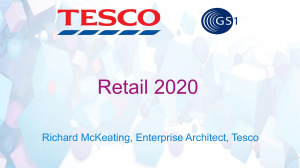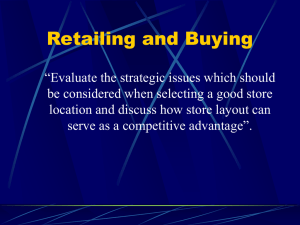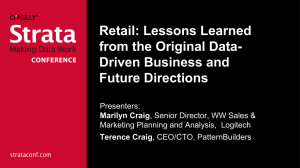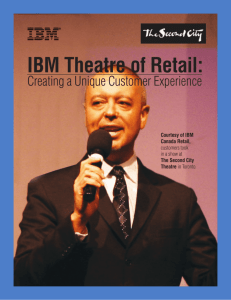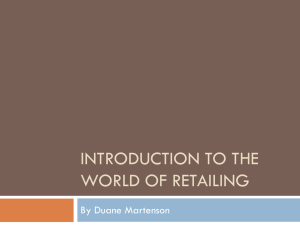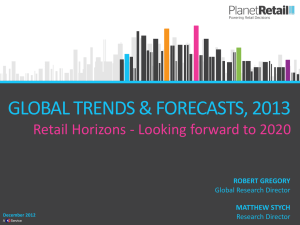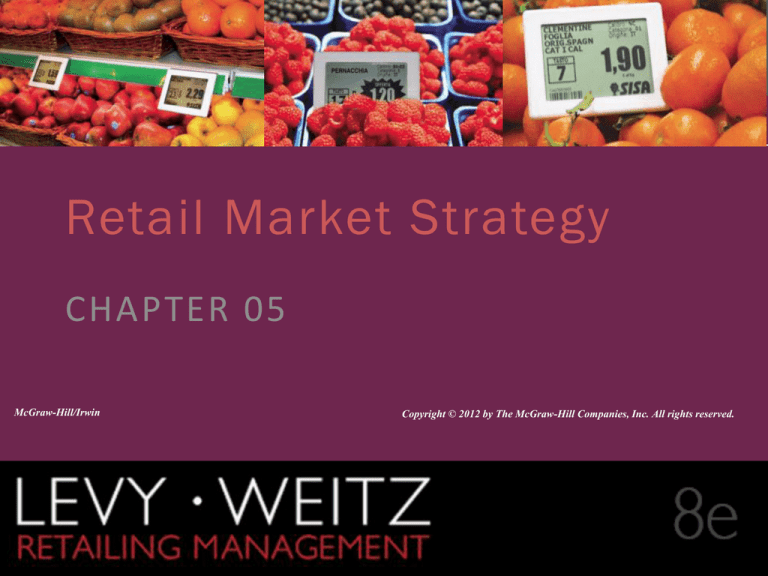
CHAPTER 5
2
1
Retail Market Strategy
CHAPTER 05
McGraw-Hill/Irwin
Retailing Management 8e
Copyright © 2012 by The McGraw-Hill Companies, Inc. All rights reserved.
© The McGraw-Hill Companies, All rights reserved.
5-1
Retailing Strategy
CHAPTER 5
2
1
5-2
Retailing Strategy
CHAPTER 5
2
1
Retail Market Strategy
Financial Strategy
Retail Locations
Retail Site Location
Human Resource Management
Information Systems and Supply Chain Management
Customer Relationship Management
5-3
Questions
CHAPTER 5
2
1
• What is a retailing strategy?
• How can a retailer build a sustainable competitive
advantage?
• What steps do retailers go through to develop a
strategy?
• What different strategic growth opportunities can
retailers pursue?
• What retailers are best positioned to become global
retailers?
5-4
More attention to long-term strategic
planning than ever before
CHAPTER 5
2
1
• Due to the emergence
of
•
•
•
•
New competitors
New formats
New technologies
Shifts in customer needs
5-5
Elements in Retail Strategy
CHAPTER 5
2
1
• Target Market
• the market segment(s) toward which the retailer plans
to focus its resources and retail mix
• Retail Format
• the nature of the retailer’s
operations—its retail mix
• Sustainable Competitive
Advantage
• an advantage over the competition
© image100 Ltd
5-6
Criteria For Selecting A Target Market
CHAPTER 5
2
1
• Attractiveness -- Large,
Growing, Little
Competition More
Profits
• Consistent with Your
Competitive
Advantages
Rim Light / PhotoLink / Getty Images
5-7
Can A Retailer Develop a Sustainable
Competitive Advantage by:
CHAPTER 5
2
1
• Dropping the Price of Your Merchandise?
• Building a Store at the Best Location?
• Deciding to Sell Some Hot Merchandise?
• Increasing Your Level of Advertising?
• Attracting Better Sales Associates by Paying Higher
Wages?
• Providing Better Customer Service?
5-8
Sources of Competitive Advantage
More Sustainable
• Location
• Customer Loyalty
• Customer Service
• Exclusive Merchandise
• Low Cost Supply Chain
Management
• Information Systems
• Buying Power with Vendors
• Committed Employees
CHAPTER 5
2
1
Less Sustainable
• Better Computers
• More Employees
• More Merchandise
• Greater Assortments
• Lower Prices
• More Advertising
• More Promotions
• Cleaner Stores
5-9
Customer Loyalty
CHAPTER 5
2
1
• More than simply liking one retailer over another
• Customers will be reluctant to patronize competitive
retailers
• Retailers build loyalty by:
• Developing a strong brand for the store or store
brands
• Developing clear and precise positioning strategies
• Creating an emotional attachment with customers
through loyalty programs
5 - 10
Retail Branding
CHAPTER 5
2
1
Stores use brand (store’s name and store brands –
private label brands) to build customer loyalty
• Retail brand
• Can create an emotional
tie with customers that
build their trust and
loyalty
• Facilitates store loyalty
because it stands for a
predictable level of quality
5 - 11
Approaches for Building
Customer Loyalty
CHAPTER 5
2
1
• Brand Image
• Positioning
• Unique Merchandise
• Customer Service
• Customer Relationship Management Programs
5 - 12
Example of Positioning
CHAPTER 5
2
1
5 - 13
Vendor Relationships
CHAPTER 5
2
1
• Low Cost - Efficiency Through Coordination
• Electronic Data Interchange (EDI)
• Collaborative Planning and Forecasting to Reduce
Inventory and Distribution Costs
• Exclusive Sale of Desirable Brands
• Special Treatment
• Early Delivery of New Styles
• Shipment of Scare Merchandise
5 - 14
Human Resources Management
CHAPTER 5
2
1
• “Employees are key to build a sustainable competitive
advantage”
• Strategies for Recruiting and Retaining Talented
Employees
• Employee Branding
• Develop positive organizational culture
5 - 15
Distribution and Info Systems
Flow of Information
Vendor
Distribution Center
Store
CHAPTER 5
2
1
By decreasing costs here, the
is more money available to
invest in:
-Better services
-Increase in breadth and depth
-Decrease in prices
5 - 16
Location
CHAPTER 5
2
1
• What are the three most important things in retailing?
• “location, location, location”
• Location is a competitive advantage
• A high density of Starbucks stores
• Creates a top-of-mind awareness
• makes it very difficult for a competitor to enter a
market and find a good locations
5 - 17
Growth Strategies
CHAPTER 5
2
1
• Market Penetration
• Market Expansion
• Retail Format Development
• Diversification
• Related vs. Unrelated
Ryan McVay/Getty Images
5 - 18
Growth Opportunities
CHAPTER 5
2
1
5 - 19
Market Penetration
CHAPTER 5
2
1
• Attract customers from target market – Walgreens “on every
corner”
• Get current customer to visit store more often or buy on each
visit
Cross Selling – sales associates in one department sell complimentary
merchandise from other departments
Example: Manicurist sells services plus hand lotion or nail polish
Example: Salesperson sells leaf blower directs customer to electrical
department to purchase a 100 foot extension cord.
5 - 20
Market Expansion
CHAPTER 5
2
1
• Market expansion growth opportunity involves using the
existing retail format in new market segments
• Dunkin’ Donuts – new stores (and at gas stations)
outside northeastern
• Abercrombie & Fitch (for college students) opens
lower-priced chain Hollister Co. for high school
students
5 - 21
Retail Format Development
CHAPTER 5
2
1
• Develops a new retail format with a different retail mix for
the same target market
• Multi-channel retailing
• UK based TESCO:
• Tesco Express: small stores located close to where
customers live and work
• Tesco Metro: bring convenience to city center location by
specializing in ready-to-eat meals
• Tesco Superstores: traditional stores
• Tesco Extra: one-stop destination with the widest range of
food and non-food products
5 - 22
Diversification
CHAPTER 5
2
1
• Introduces a new retail format toward a market segment
that is not currently served by the retailer
• Related diversification
• Unrelated diversification
• Vertical integration into wholesaling or manufacturing
5 - 23
Global Growth Opportunities
CHAPTER 5
2
1
• China
• Increasing operating costs
• Lack of managerial talent
• Underdeveloped and
inefficient supply chain
• India
• Prefers small family-owned
stores
• Restricts foreign
investment
5 - 24
Key to Success in Global Retailing
CHAPTER 5
2
1
• Globally sustainable competitive advantage
• Low cost, efficient operations - Wal-Mart, Carrefour
• Strong private label brands: Starbucks, KFC
• Fashion Reputation - The Gap, Zara, H&M
• Category dominance – Best Buy, IKEA, Toys R Us
• Adaptability
• Global Culture
• Financial Resources
5 - 25
International Market Entry Strategies
CHAPTER 5
2
1
Direct Investment
Joint Ventures
Strategic Alliances
Franchising
5 - 26
Stages in the Strategic
Retail Planning Process
CHAPTER 5
2
1
5 - 27
Elements in a Situation Audit
CHAPTER 5
2
1
5 - 28
Market Factors
CHAPTER 5
2
1
• Market size – large markets attractive to large retail
firms
• Growth – typically more attractive than mature or
declining
• Seasonality – can be an issue as resources are necessary
during peak season only
• Business cycles – retail markets can be affected by
economic conditions – military base towns
5 - 29
Competitive Factors
CHAPTER 5
2
1
• Barriers to entry
• Scale economies of big box retailers
• Service and unique, high-end products of small
retailers
• Bargaining power of vendors
• Markets are less attractive when only a few vendors
control the merchandise sold within it
5 - 30
Competitive Factors
CHAPTER 5
2
1
• Competitive rivalry
• Defines the frequency and intensity of reactions to
actions undertaken by competitors
• Conditions leading to intense rivalry: a large number
of same size retailers, slow growth, high fixed costs, a
lack of perceived differences between competing
retailers
5 - 31
Questions for
Analyzing the Environment
CHAPTER 5
2
1
• New developments or changes -- technologies,
regulations, social factors, economic conditions
• Likelihood changes will occur
• Key factors determining change
• Impact of change on retail market firm, competitors
5 - 32
Performing a Self-Analysis
CHAPTER 5
2
1
• At what is our company good?
• In which of these areas is our company better than our
competitors?
• In which of these areas does our company’s unique
capabilities provide a sustainable advantage or a basis
for developing one?
Stockbyte/Punchstock Images
5 - 33
Keywords
CHAPTER 5
2
1
• brand image Set of associations consumers have about
a brand that are usually organized around some
meaningful themes.
• positioning The design and implementation of a retail
mix to create in the customer’s mind an image of the
retailer relative to its competitors. Also called brand
building.
5 - 34




